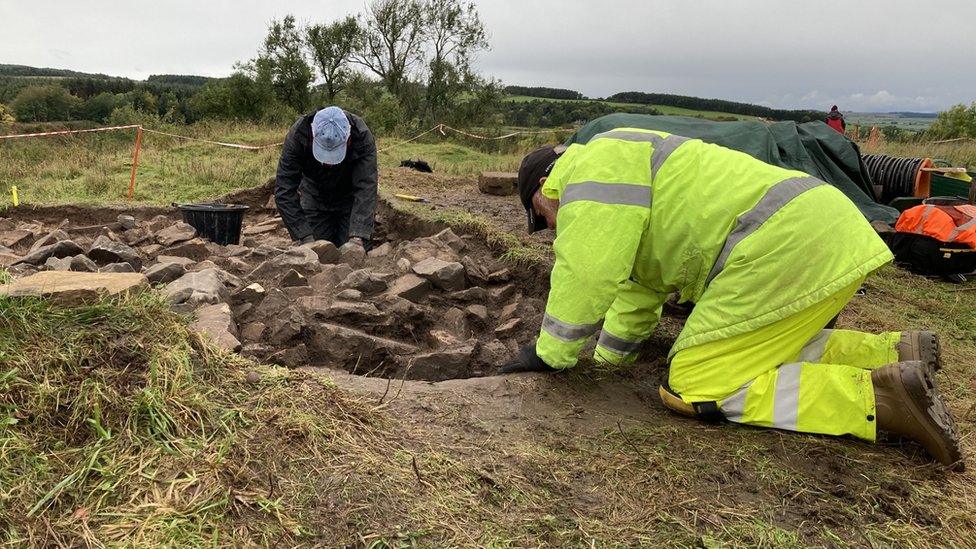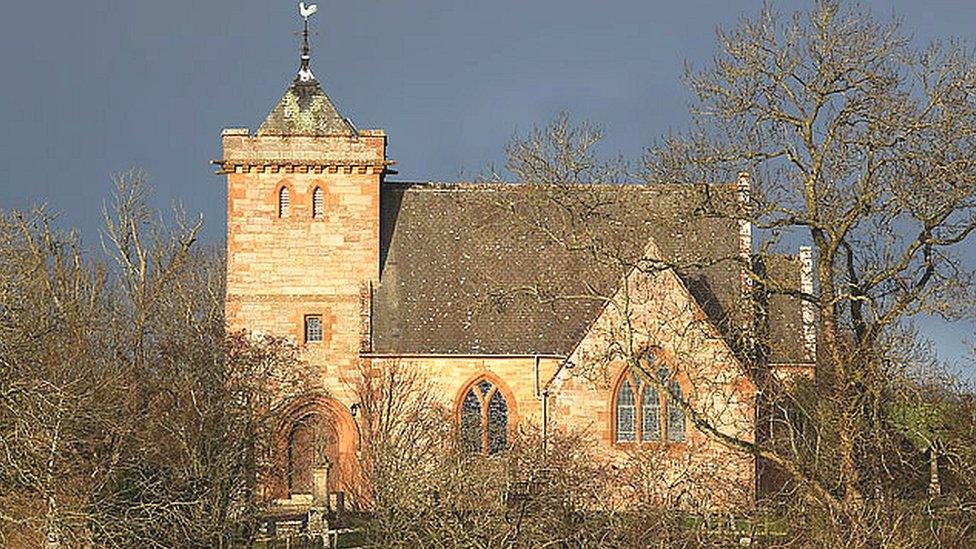Archaeologists search for Borders valley's day of destruction
- Published

Archaeologists are uncovering the walls of Bedrule Castle
Archaeologists are hoping to leave a different type of mark on a remote Borders valley destroyed by an English army almost 500 years ago.
During a single day in 1545, a 15,000-strong force burned and pulled down more than a dozen strongholds in the Rule Valley.
Fields of corn and smaller settlements were also destroyed.
Archaeology Scotland is now excavating Bedrule Castle to improve understanding of the raid and its aftermath.
With a second spell at the rural site coming to an end this week, project manager Phil Richardson is happy with the finds and discoveries that have been made so far.
He said: "Our intention was to leave behind a much clearer picture of what was here and what happened, and I feel we are achieving that."
From historical records, at least a dozen towers and castles along the winding Rule Valley were destroyed during a 10-hour raid on 16 September 1545.
Historians and archaeologists agree that Bedrule Castle was the largest of the buildings which came under attack during the raid.

Volunteers excavate around an area where a spiral staircase is believed to have been located
Following digs last November and again this autumn, the experts are confident that the castle was abandoned for good in the decades after Lord Hertford's soldiers launched their attack.
Project officer Kieran Manchip said: "Although it may not have been completely destroyed during the attack, we established last November that the castle had been abandoned for good later in the 16th Century.
"A lot of the cut stones - that's the facing stones from walls, flag stones from floors and lintels from windows and doors - ended up in the church and manse, as well as a few dykes around the area.
"The excavations and geophysics from here at Bedrule will help build up a bigger picture of what happened across this valley."

Archaeologists have found stones from the castle in the walls of nearby Ruberslaw Parish Church
In an attempt to weaken the Auld Alliance between Scotland and France, English forces regularly undertook violent and destructive raids across the border between 1543 and 1551, now known as the Rough Wooing.
Following an embarrassing defeat for Henry VIII at Ancrum Moor, north of Jedburgh, in February 1545, where Borders soldiers switched sides to join the Scots, a few months later a much larger army, under the command of Lord Hertford, marched north to seek revenge across Teviotdale and Tweeddale.
What exactly happened on 16 September in the Rule Valley has now come under the spotlight as the Twelve Towers of Rule campaign.
Having already hosted hundreds of pupils from local schools in the Borders and dozens of volunteers from the community, Archaeology Scotland is delighted with the interest being shown.

Archaeologists have found stones from the castle in the walls of nearby Ruberslaw Parish Church
Mr Richardson added: "A large part of this project is about getting people involved - I think we've now had every high school in the Borders spend some time with us.
"We are learning more about Bedrule Castle and what happened every day that we are on site.
"We will relocate to a site at Bonchester Town Head, further up the valley, in November and then hopefully we can return to Bedrule again next year to find out even more."
Backed by more than £80,000 from the UK Government's Community Renewal Fund, Archaeology Scotland staff have also welcomed people from disadvantaged backgrounds to help with recording finds.
Once the archaeology work is completed, plans are being drawn up to create a walking trail along the main sites with interpretation boards in place.